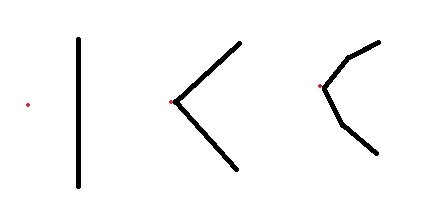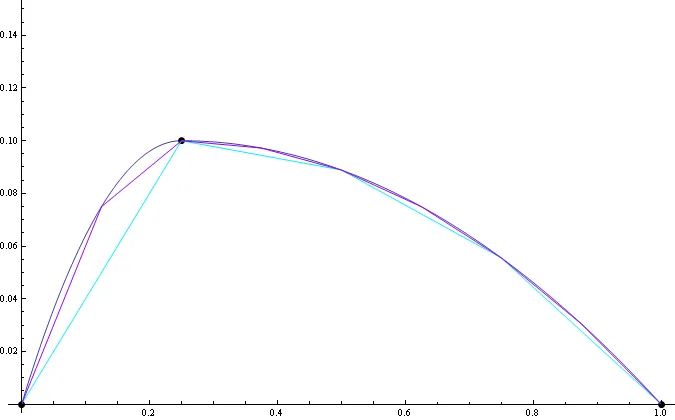您可能需要自己编写代码。我认为您可以通过在代码中实现二次贝塞尔曲线函数来实现,并且可以在
这里找到该函数。只需求解少数值即可确定所需的细分程度。如果想要一条直线,只需求解0和1并将这些点用直线连接起来。如果想要一个角度样例,可求解0、0.5和1,并依次连接这些点。如果要实现第三个样例,需求解0、0.25、0.5、0.75和1。最好将其放入for循环中,如下面所示:
float stepValue = (float)0.25;
float lastCalculatedValue;
for (float t = 0; t <= 1; t += stepValue)
{
}
编辑:实际上,看起来你想让线条通过你的控制点。如果是这种情况,你不应该使用二次贝塞尔曲线,而是应该使用拉格朗日曲线。这个网站可能会帮助你解方程: http://www.math.ucla.edu/~baker/java/hoefer/Lagrange.htm。但无论哪种情况,你都可以使用同样类型的循环来控制平滑度。
第二次编辑:这个代码似乎可以工作。只需将numberOfSteps成员更改为你想要的所有线段的总数,并适当设置points数组即可。顺便说一句,你可以使用超过三个点。它只是将总线段数分配给它们。但我初始化了这个数组,以便结果看起来像你的最后一个例子。
第三次编辑:我稍微更新了代码,这样你就可以在窗体上左键点击添加点,右键点击删除最后一个点。此外,我还添加了一个NumericUpDown到底部,这样你就可以在运行时更改分割数。
public class Form1 : Form
{
private int numberOfSegments = 4;
private double[,] multipliers;
private List<Point> points;
private NumericUpDown numberOfSegmentsUpDown;
public Form1()
{
this.numberOfSegmentsUpDown = new NumericUpDown();
this.numberOfSegmentsUpDown.Value = this.numberOfSegments;
this.numberOfSegmentsUpDown.ValueChanged += new System.EventHandler(this.numberOfSegmentsUpDown_ValueChanged);
this.numberOfSegmentsUpDown.Dock = DockStyle.Bottom;
this.Controls.Add(this.numberOfSegmentsUpDown);
this.points = new List<Point> {
new Point(100, 110),
new Point(50, 60),
new Point(100, 10)};
this.PrecomputeMultipliers();
}
public void PrecomputeMultipliers()
{
this.multipliers = new double[this.points.Count, this.numberOfSegments + 1];
double pointCountMinusOne = (double)(this.points.Count - 1);
for (int currentStep = 0; currentStep <= this.numberOfSegments; currentStep++)
{
double t = currentStep / (double)this.numberOfSegments;
for (int pointIndex1 = 0; pointIndex1 < this.points.Count; pointIndex1++)
{
double point1Weight = pointIndex1 / pointCountMinusOne;
double currentMultiplier = 1;
for (int pointIndex2 = 0; pointIndex2 < this.points.Count; pointIndex2++)
{
if (pointIndex2 == pointIndex1)
continue;
double point2Weight = pointIndex2 / pointCountMinusOne;
currentMultiplier *= (t - point2Weight) / (point1Weight - point2Weight);
}
this.multipliers[pointIndex1, currentStep] = currentMultiplier;
}
}
}
protected override void OnPaint(PaintEventArgs e)
{
base.OnPaint(e);
Point? previousPoint = null;
for (int currentStep = 0; currentStep <= numberOfSegments; currentStep++)
{
double sumX = 0;
double sumY = 0;
for (int pointIndex = 0; pointIndex < points.Count; pointIndex++)
{
sumX += points[pointIndex].X * multipliers[pointIndex, currentStep];
sumY += points[pointIndex].Y * multipliers[pointIndex, currentStep];
}
Point newPoint = new Point((int)Math.Round(sumX), (int)Math.Round(sumY));
if (previousPoint.HasValue)
e.Graphics.DrawLine(Pens.Black, previousPoint.Value, newPoint);
previousPoint = newPoint;
}
for (int pointIndex = 0; pointIndex < this.points.Count; pointIndex++)
{
Point point = this.points[pointIndex];
e.Graphics.FillRectangle(Brushes.Black, new Rectangle(point.X - 1, point.Y - 1, 2, 2));
}
}
protected override void OnMouseClick(MouseEventArgs e)
{
base.OnMouseClick(e);
if (e.Button == MouseButtons.Left)
{
this.points.Add(e.Location);
}
else
{
this.points.RemoveAt(this.points.Count - 1);
}
this.PrecomputeMultipliers();
this.Invalidate();
}
private void numberOfSegmentsUpDown_ValueChanged(object sender, EventArgs e)
{
this.numberOfSegments = (int)this.numberOfSegmentsUpDown.Value;
this.PrecomputeMultipliers();
this.Invalidate();
}
}
 以此类推。我尝试了各种方法,例如从初始线的中心取角度,然后在角度导致的点处分割线条,但是我在长度方面有问题。我只会将初始长度除以我所在的步骤数,但那并不完全正确。
以此类推。我尝试了各种方法,例如从初始线的中心取角度,然后在角度导致的点处分割线条,但是我在长度方面有问题。我只会将初始长度除以我所在的步骤数,但那并不完全正确。 以此类推。我尝试了各种方法,例如从初始线的中心取角度,然后在角度导致的点处分割线条,但是我在长度方面有问题。我只会将初始长度除以我所在的步骤数,但那并不完全正确。
以此类推。我尝试了各种方法,例如从初始线的中心取角度,然后在角度导致的点处分割线条,但是我在长度方面有问题。我只会将初始长度除以我所在的步骤数,但那并不完全正确。 以下是得到此图的方法:
以下是得到此图的方法: